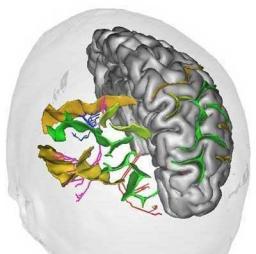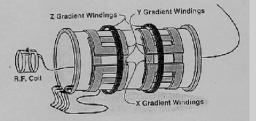11.7-tesla superconducting magnet
High fields allow us to increase the spatial and temporal resolution of the imagery. A pre-study has shown that it is possible to build a magnet of 11.7 T of 900 mm effective diameter - from niobium-titanium cooled by superfluid helium to 1.8 K – at the same time as meeting field uniformity constraints (0.1 ppm in a 10 cm sphere) and low fringe field constraints (B < 5.10-4 T at 5 m radially and 9.6 m axially from magnet centre). The magnetic system obtained has a stored energy of 300 MJ and overall dimensions of 4.1 m in length and 3.2 m in diameter. This study was carried out by the SACM in joint partnership with the SIS.Magnetic field gradient coils
High fields involve the use of high performance gradient systems, which have high field gradient amplitude and short switching time. Traditional gradient coils used in the NMR magnets are subject to considerable cyclic stressing induced by gradient switching in a high static field; they are therefore fragile and emit high levels of noise. Distribution of the mechanical stresses over a traditional system has been analysed and has allowed us to understand where the noise comes from. Professor Guy Aubert, a scientific advisor at Dapnia, has therefore suggested a new magnet structure whose specific characteristic would be a considerable reduction in the stresses, which should translate into large reductions in noise. This suggestion has been the subject of a patent application. Prototype testing is planned to take place in 2004.High frequency antennas
These antennas are used to generate a radio frequency wave (RF) whose magnetic field allows excitation of the nuclei of hydrogen atoms within the sample placed in the cavity, as well as transduction of the very weak radio frequency signal which results from NMR relaxation. SACM has modelled the antennas traditionally used and shown that they could not operate at 500 MHz, the resonating frequency of the protons corresponding to the main field of 11.7 T. A new antenna structure has been suggested by SACM, and a prototype model has been built by the Service d’électronique, des détecteurs et d’informatique. This prototype is currently under test. Specific absorption rate (SAR) measurements will also be carried out to check that the power generated by the RF pulses in the tissues of the human head remains within acceptable limits.• Irfu expertise working for the society
• The Electronics, Detectors and Computing Division • Accelerators, Cryogenics and Magnetism Division (DACM) • The Systems Engineering Division



